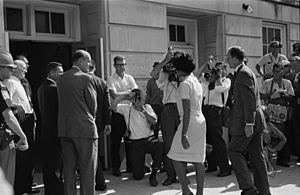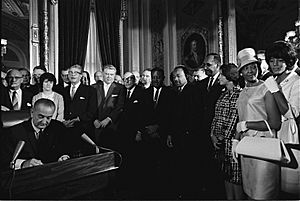Vivian Malone Jones facts for kids
Quick facts for kids
Vivian Juanita Malone Jones
|
|
|---|---|

Malone registering for classes at University of Alabama
|
|
| Born | July 15, 1942 |
| Died | October 13, 2005 (aged 63) |
| Alma mater | Alabama A&M University University of Alabama |
| Known for | Integrating the University of Alabama |
| Spouse(s) | Mack Arthur Jones |
| Children | 2 |
| Relatives | Eric Holder (brother-in-law) Jeff Malone (nephew) |
Vivian Juanita Malone Jones (July 15, 1942 – October 13, 2005) was a brave American woman. She was one of the first two Black students to join the University of Alabama in 1963. In 1965, she became the university's first Black graduate. She became famous when George Wallace, the Governor of Alabama, tried to stop her and James Hood from enrolling. This event is known as the Stand in the Schoolhouse Door.
Contents
Early Life and Education
Growing Up in Alabama
Vivian Malone was born in Mobile, Alabama, in 1942. She was the fourth of eight children. Her parents worked hard at Brookley Air Force Base. Her father did maintenance, and her mother worked at home.
Vivian's parents believed that getting an education was very important. They made sure all their children went to college. Her older brothers all attended Tuskegee University.
Family's Fight for Equality
Vivian's parents were also active in the civil rights movement. They went to local meetings and helped groups that wanted equality. They worked to end racial discrimination and bring desegregation to schools.
As a teenager, Vivian joined community groups that fought for fairness. She worked with local leaders to help desegregate schools.
College Before the University of Alabama
Vivian went to Central High School and was a member of the National Honor Society. In 1961, she enrolled at Alabama A&M University. This was one of the few colleges for Black students in Alabama.
She studied there for two years and earned a degree in business education. Vivian wanted to study accounting, but Alabama A&M did not offer that subject. Also, her degree was given before the university was fully approved. To get a proper accounting degree, she needed to transfer to another university.
Breaking Barriers at the University of Alabama
Applying to the University
In 1961, Vivian heard about a plan to desegregate the University of Alabama. A family friend told her that a local group, the Non-Partisan Voter League, was helping Black students apply. Because Vivian was an excellent student, she was one of many Black students asked to apply.
About 200 Black students applied, but their applications were rejected. The university said they had too many students or that the students' grades were not high enough. However, everyone knew the real reason was that the university did not want Black students because of segregation.
Facing Threats and Staying Strong
After Vivian applied, two white men visited her family. They said they were from the state and warned her that applying to the university could cause violence. They said her family would not be safe.
But these threats did not stop Vivian. She continued to support integration and kept trying to get into the University of Alabama. She was determined to earn her accounting degree.
The Court's Decision
The NAACP Legal Defense and Educational Fund helped Vivian. They worked with her to get into the University of Alabama's business school. They were also helping another student, James Hood, to desegregate the university.
After two years of discussions and court cases, Vivian and James were allowed to enroll. A judge named Harlan Hobart Grooms ordered it in 1963. The court said that denying Black students was against the U.S. Supreme Court's ruling in Brown v. Board of Education. That ruling said separating students by race was against the law. The judge also told Governor George Wallace not to interfere.
The Stand in the Schoolhouse Door
On June 11, 1963, Vivian and James arrived at the University of Alabama. They were with Nicholas Katzenbach, a U.S. Deputy Attorney General, and federal marshals. Their goal was to register for classes.
Governor Wallace was waiting for them at Foster Auditorium. He stood in the doorway, blocked by state troopers. He had promised to keep segregation in Alabama and stop integration.
Vivian and James waited in a car. Mr. Katzenbach and the marshals told Governor Wallace to move. They said he had to let the students in because of the federal court order.
Wallace refused and gave a speech to the media. He said the federal government was unfairly forcing its power on Alabama.
President Kennedy Steps In
Since Wallace would not move, Mr. Katzenbach called President John F. Kennedy. The President then took control of the Alabama Army National Guard. This meant the Guard now answered to the President, not Governor Wallace.
One hundred guardsmen took Vivian and James back to the auditorium. General Henry V. Graham asked Wallace to step aside, and he did. Vivian and James entered the building through another door.
As they walked in, white students who supported integration applauded them. Vivian and James then registered as students. Vivian was accepted as a junior.
Life at the University
Vivian's time at the University of Alabama was mostly peaceful. There was a series of bombings in November 1963, possibly by white people angry about integration. But officials decided Vivian would stay in school.
Two years later, in 1965, Vivian made history. She earned a degree in business management. She became the first Black student to graduate from the University of Alabama. She graduated with good grades.
Later Life and Career
Working for Justice
After college, Vivian did not get job offers in Alabama. She moved to Washington, D.C., and joined the civil rights division of the United States Department of Justice. She worked there as a research analyst.
While in Washington, she studied for a master's degree in public administration at George Washington University. She then worked for the United States Department of Veterans Affairs. She was there when the Voting Rights Act of 1965 was signed into law.
In 1977, Vivian became the Executive Director of the Voter Education Project. She worked to help minorities have equal voting rights. She helped provide money and support for local voter registration efforts. She also helped start Project 23. This program aimed to remove barriers that stopped Black people in Georgia from voting or running for office. By 1978, her project had helped about 3 million Black people register to vote.
Environmental Justice Work
Later, Vivian became the Director of Civil Rights and Urban Affairs. She also became the Director of Environmental Justice for the United States Environmental Protection Agency. She held this job until she retired in 1996. After retiring, she started selling life insurance.
Awards and Recognition
In 1996, Vivian received the Lurleen B. Wallace Award of Courage. It was given by the George Wallace Family Foundation. Governor Wallace said Vivian showed "grace, strength and, above all, courage."
In 2000, Vivian gave a speech at the University of Alabama's graduation. The university also gave her an honorary doctorate degree. In 2004, the Alabama State Legislature honored her for her great achievements.
Personal Life
Vivian was married to Mack Arthur Jones, a doctor. She met him when he was her driver at the University of Alabama. Mack passed away in 2004.
Vivian was a member of From the Heart Christian Ministries in Atlanta. She had two children, a son and a daughter. She also had three grandchildren, four sisters, and three brothers. Her brother-in-law, Eric Holder, became the United States Attorney General. Her nephew, Jeff Malone, was a famous basketball player.
Vivian Malone Jones passed away at age 63 on October 13, 2005. She died in an Atlanta hospital after having a stroke. Her funeral was held at the Martin Luther King Jr. International Chapel.
Legacy and Honors
In Popular Culture
The story of Vivian Malone Jones and James Hood at the University of Alabama was shown in the 1994 movie Forrest Gump. The main character in the film appeared at the event. He handed Vivian a book she dropped as she walked into Foster Auditorium.
Historical Markers and Street Names
In 2017, a historical marker was placed in Mobile, Alabama, to honor Vivian Jones. It is at the site of her childhood home. The marker is part of the Dora Franklin Finley African-American Heritage Trail.
In 2018, a street in downtown Mobile was named after her.
Community Impact and Scholarships
In 2018, JaVaughnae Malone and her mother, Janice, started a nonprofit group called Vivian's Door. This group helps minority-owned businesses in south Alabama. They offer training, resources, and networking. Their work was inspired by Vivian Malone Jones.
The University of Alabama gives a student the Vivian Malone Jones Endowed Scholarship for Diversity each year. In 2014, the Environmental Protection Agency created the Vivian Malone Jones Legacy Award. This award honors someone who shows integrity and works for social justice.
See also
 In Spanish: Vivian Malone Jones para niños
In Spanish: Vivian Malone Jones para niños
- The McDonogh Three
- Little Rock Nine
- James Meredith


